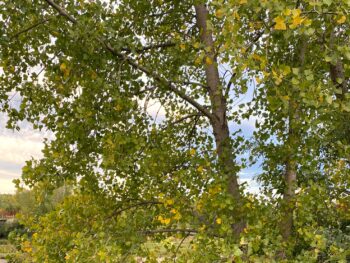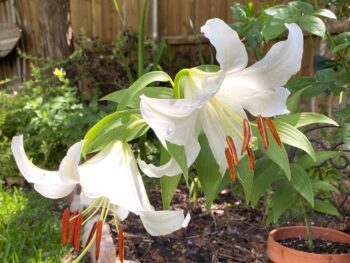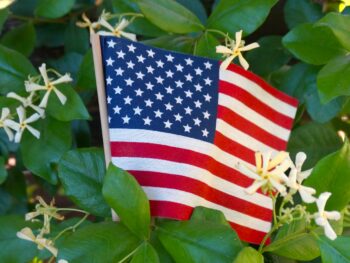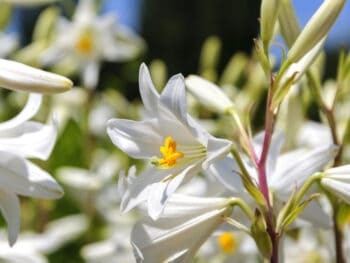Have you ever prayed for a “hedge of protection” around someone you love, someone you were concerned about, or a community at risk? This prayer was passed on to me when I was new to faith by a devoted group of persevering prayer mamas, while accompanying them in desperate intercession for a child in danger. My ears perked up and my understanding blossomed instantly at the botanical imagery in this prayer of seeking God’s defense—long before I knew I would write about garden-related Scriptures! Without hesitation, I have adopted it over the years to impart security, sanctuary, and a stalwart heart to those in the throes of difficult seasons of spiritual growth, which is accompanied predictably by evil attack.
Let’s dig into the Words inspiring the hedge of protection prayer and the plants of the Bible for growing actual garden hedges.
Hedge of Protection in God’s Word
God teaches us about the spiritual metaphor of a hedge of protection and its purposes in a series of Scriptures primarily in the Old Testament. Its most prominent mention comes from describing the surround of shelter Job enjoyed, safeguarding his blessed life:
Have You not put a hedge [of protection] around him and his house and all that he has, on every side? You have blessed the work of his hands [and conferred prosperity and happiness upon him], and his possessions have increased in the land. Job 1:10 AMP
You have put a protective hedge around him and his household and everything that belongs to him, haven’t you? You have blessed the work of his hands. Job 1:10 EHV
Of course, the rest of the Book of Job tells the story of what it is like to have that hedge removed, yikes! Additionally, Jesus nuanced the cultural practice of keeping a hedge of protection in place in two of the parables He told:
He began to speak to them in parables. “A man planted a vineyard, and set a hedge around it, and dug a pit for the winepress, and built a tower, and rented it to vinedressers, and went to a far country…” Mark 12:1 MEV
“Then the master told the servant, ‘Go out into the highways and hedges and make them come in, so that my house may be filled…’ Luke 14:23 CSB
Jesus confirmed the use of hedges in a commonplace, a matter-of-fact manner, a regular part of caring for vineyards and fields. Yet the spiritual metaphor is more vividly revealed in the Old Testament; there its lessons prove to be a bit more sticky.
Hedge of Protection Purposes
More Old Testament detail on the physical hedges show them to be made up of thorns, an intimidating border essential in establishing a fierce, spikey edge, one resistant to hungry wildlife and intruders with ill-intent. Such unwanted visitors become metaphors for the enemies of our garden life with God, described in Ephesians 6:12. So the hedges keep us sheltered from evil beyond.
Secondly, serrated slashings experienced when moving through a thorny thicket picture the painful severity of brushing with evil. So the sharp edge, metaphorically, warned of crossing into enemy territory. No wonder Hosea employed the prickly perimeter to poke his bride and keep her protected from continuing headlong in her promiscuous, destructive ways:
But I’ll block her way with a thorn hedge; I’ll put a wall up around her, blocking her usual paths Hosea 2:6 VOICE

On the flip side, the hedge of protection would be removed from the nation of Israel, rushing them with thick of their defiance to ultimately point their attention back to God.
“Now I will tell you what I will do to my vineyard: I will pull up the thornbushes that protect it, and I will burn them. I will break down the stone wall and use the stones for a walkway. Isaiah 5:5 ERV
“Now, let me tell you, won’t you please, what I’m going to do to my vineyard. “I’m going to take away its protective hedge, and it will be devoured; I’ll break down its wall, and it will be trampled. Isaiah 5:5 ISV
The psalmist Asaph chronicled the withdrawal of Israel’s protective defense as well:
Why have You broken down its hedges, So that all who pass that way pick its fruit? Psalm 80:13 NASB
Because of your favor on your vineyard [Israel], blessing extended to every mountain of influence…So Lord, why have you broken down your fence of favor around us? Psalm 80:10,12 TPT
The hedge of protection holds God’s people captive and active to God’s ways, securing the blessed, abundant garden life the Lord desires to live with us; yet the hedge is painfully sharp by design, delineating the edge of evil, matching the thorny nature of life without God.
Perimeter Secured
The thorns serve a third purpose, metaphorically. Additional references by the prophets Micah and Nahum illustrate the entangling nature of spiritual hedges, meant to ensure an ensnaring demise to those trying to advance evil corruption:
The best of them is as painful to deal with as a briar, the most honest of them like a hedge heavy with thorns. So the day your watchmen have awaited—the day of your punishment—has come. Now you will be confused and confounded. Micah 7:4 VOICE
Like a thicket of thornbushes, they are entangled; like dry straw they will be utterly consumed. From your number, one has emerged who plots evil against the Lord and counsels wickedness. Thus says the Lord: No matter how numerous they are, no matter how great their strength, they will be cut down and pass away. Nahum 1:10-12 NCB
The thorniness of the hedge of protection is what is needed to contend with evil. Though I thought I would be bringing you lovely, soft-leaved suggestions of boxwood and myrtle for hedges to grow in your garden, the Lord has led us to spiny species instead!
Thorny Hedges
What were these thorny hedges, specifically? That’s hard to pinpoint, with many shrubs that grow in the Biblical landscape forming thorns along their branches. Likewise, a multitude of words in Old Testament Hebrew refer to spikey plants, conveying the likes of thorns, thistles, briers, brambles, and prickly weeds. It is a common lament among Biblical botanists, trying to sort out the plants and the Words and match species precisely to Scriptures.
The Holy Land had, and has, a particularly lush crop of armored plants, and travellers tell that certain infested regions are virtually impassable to the pedestrian on account of the spiked undergrowth. This barrier feature was utilized by farmers and husbandmen to protect their fields and vineyards against thieves and trespassers.
Alastair I. MacKay, Farming and Gardening in the Bible, 1950, page 171
Several candidates from Rhamnaceae, the buckthorn family, were likely effective in fortifying the perimeters of cultivated lands, and Rhamnus palaestina, now named Rhamnus lycioides ssp. graeca, stands out as the best match to the hedge of protection metaphor, according to Harold and Alma Moldenke, authors of Plants of the Bible, and Winnifred Walker, All the Plants of the Bible. As you might expect, this plant is not available commercially (view observations of this plant on iNaturalist here), but there are a few other buckthorns we could grow to symbolize this powerful prayer in our gardens.
Proven Winners Fine Line® Buckthorn

Proven Winners®Color Choice®Shrubs and Bushes offers Fine Line® Buckthorn, Rhamnus frangula ‘Ron Williams’ USPP 14,791, adding a unique interest to garden hedging. Thankfully, there are no thorns! Plenty of soft, ruffly, feathered leaves fill out this tall, non-invasive cultivar, which can be planted 3 to 5 feet apart in full sun or part shade. Hardy to Zone 2 – not the usual for Bible-like plants – this buckthorn will reach fence height and make a great backdrop as a verdant border between garden spaces. Its overall oval form means little pruning and shaping required. Deciduous with modest fall color. Photo courtesy Proven Winners
Carolina Buckthorn

Carolina buckthorn, Rhamnus caroliniana, is a native buckthorn, at home in much of middle and northeastern America, hardy to zone 5. Also deciduous, this tall shrub or small tree will grow to 15 feet or more, spreading nearly as wide. It is accustomed to understory shade, needing 3 to 4 hours of sunlight a day. Bright, delightful clusters of berries appear after spring flowering, and they are edible if you can beat the birds to harvest them in the fall. Great for garden privacy.
Jujube

Another Rhamnaceae plant, from a different genus though generally considered among Biblical plants, jujube, Ziziphus jujuba,is also a possible “hedge of protection” stand in. This tall shrub or small tree, growing 15 to over 25 feet, does come with thorns, in case you want to be authentic! It closely resembles the thorny Ziziphus spina-christi, the plant thought to be the crown of thorns. Like the Carolina buckthorn, jujube yields a plentiful crop of small, edible fruits. Jujube is also deciduous and requires full sun. Hardy to zone 6. Photo taken at Israel Prayer Garden, Corinth, TX

Last Word: Jesus Was Pierced
In His customary, poetic brilliance, the Lord gives us a horticultural detail in Christ’s death that points back to thorny hedges.
But he was pierced because of our rebellion, crushed because of our iniquities Isaiah 53:5 CSB
Imagine moving through a barbed, thicket-hedge, thorns stabbing and scratching from every branch. This is a metaphor for what our Savior did for us. Jesus was pierced, a hint to the hedge of protection, facing off at the frontline of our fortification, engaging evil at its piercing edge, combating for our victory.
That He wore a crown of thorns is a story for another day!*
Closing Prayer
O Lord, thank you for the blessings You put in our lives. You are good and all You do is good (Psalm 119:68). Let these hedge of protection metaphors poke my mind and heart to learn more from You. Help me know that even thorny situations and my prickly past will serve Your ultimate purposes to hedge me in a delightful, garden-like relationship with You, and to make me aware and prick my attention when I am leaving the path You set for me. In the end, it will be evil and corruption that will be confined to a thorny thicket, hallelujah! Thank You, Jesus, for being willing to be pierced for me. You rescued me and I am so glad! Now Lord, help me see who needs a hedge of protection around them; let me be alert and ready to dispatch this garden prayer! In the Name of Jesus, Amen.

When I’m feeble and overwhelmed by life, guide me into your glory, where I am safe and sheltered. Lord, you provide a paradise of protection to me…none of my foes can touch when I’m held firmly in your wrap-around presence. Psalm 61:2-3 TPT


*Crown of Thorns is a topic in my recent book, My Father is the Gardener – read the 4th chapter to learn more about the role of thorns in God’s Word, connecting Genesis 3:18 to Mark 15:17, and so much more

Learn about another thornbush, Ziziphus spina-christi, in the Garden in Delight Plant Guide
Photo Credits: Cover Photo © Soniabonet | Dreamstime.com | Photo 116765433 | Color | Rhamnus lycioides plant in the garden; Proven Winners Fine Line® Buckthorn, Rhamnus frangula ‘Ron Williams’ USPP 14,791 from their website; Carolina Buckthorn © Kclarksphotography | Dreamstime.com | Photo 301520484 | These beautiful berries are called Carolina Buckthorn, Rhamnus caroliniana, and grow all over our area of north Alabama in Limestone, and Morgan County USA; all other photos ©Shelley S. Cramm
AMP notes Scripture quotations taken from the Amplified® Bible, Copyright © 2015 by The Lockman Foundation. Used by permission. www.Lockman.org
CSB notes Scripture quotations taken from the Christian Standard Bible®, Copyright © 2017 by Holman Bible Publishers. Used by permission. Christian Standard Bible® and CSB® are federally registered trademarks of Holman Bible Publishers.
EHV notes Scripture quotations taken from The Holy Bible, Evangelical Heritage Version® , EHV®, © 2019 Wartburg Project, Inc. All rights reserved. Used by permission.
ERV denotes Scripture quotations taken from the HOLY BIBLE: EASY-TO-READ VERSION © 2014 by Bible League International. Used by permission.
ISV denotes Scripture quotations from The Holy Bible: International Standard Version. Release 2.0, Build 2015.02.09. Copyright © 1995-2014 by ISV Foundation. ALL RIGHTS RESERVED INTERNATIONALLY. Used by permission of Davidson Press, LLC.
MEV denotes Scripture quotations taken from The Holy Bible, Modern English Version. Copyright © 2014 by Military Bible Association. Published and distributed by Charisma House. All rights reserved.
NASB denotes Scripture quotations taken from the NEW AMERICAN STANDARD BIBLE®, Copyright © 1960,1962,1963,1968,1971,1972,1973,1975,1977,1995 by The Lockman Foundation. Used by permission.
NCB denotes Scripture taken from the SAINT JOSEPH NEW CATHOLIC BIBLE® Copyright © 2019 by Catholic Book Publishing Corp. Used with permission. All rights reserved.
TPT denotes Scripture quotations taken from The Passion Translation®. Copyright © 2017, 2018, 2020 by Passion & Fire Ministries, Inc. Used by permission. All rights reserved. ThePassionTranslation.com
VOICE denotes Scripture quotations taken from The Voice™. Copyright © 2012 by Ecclesia Bible Society. Used by permission. All rights reserved.














